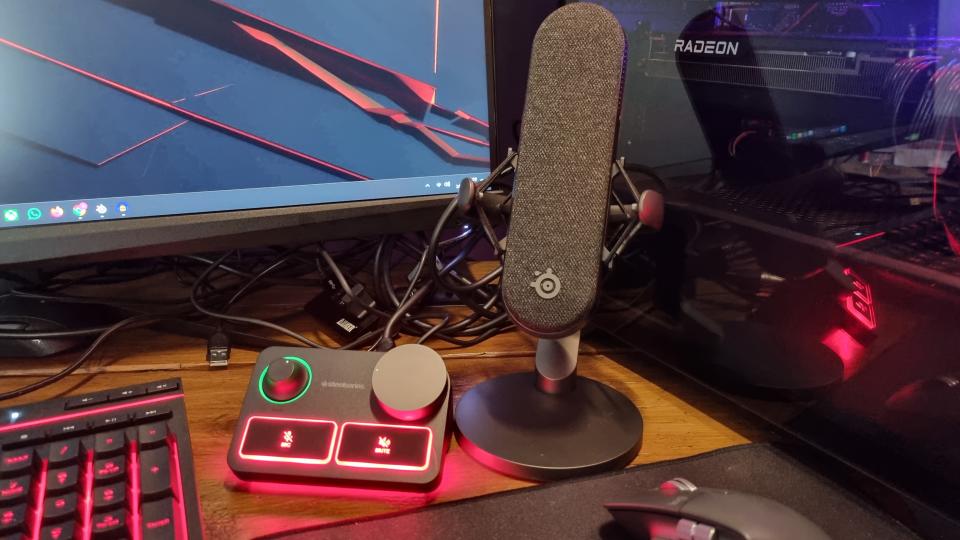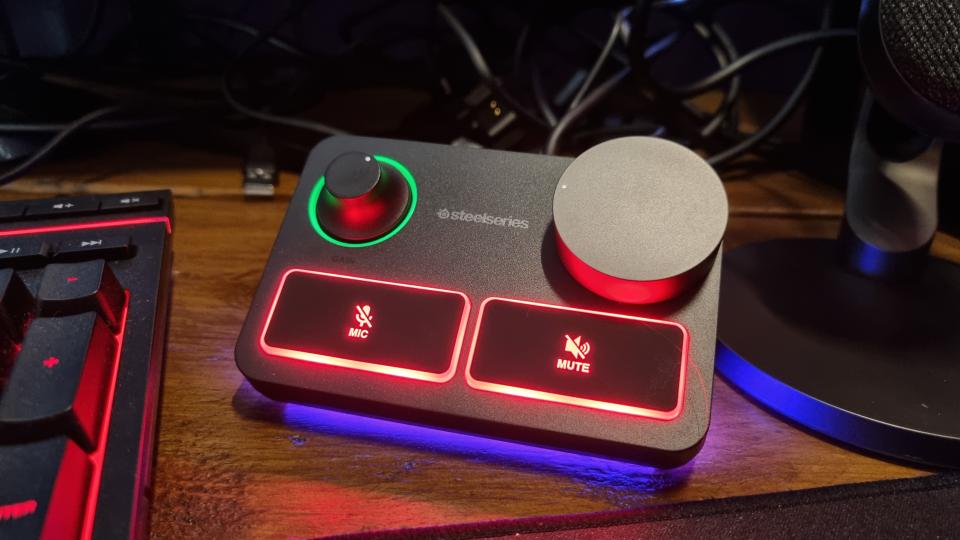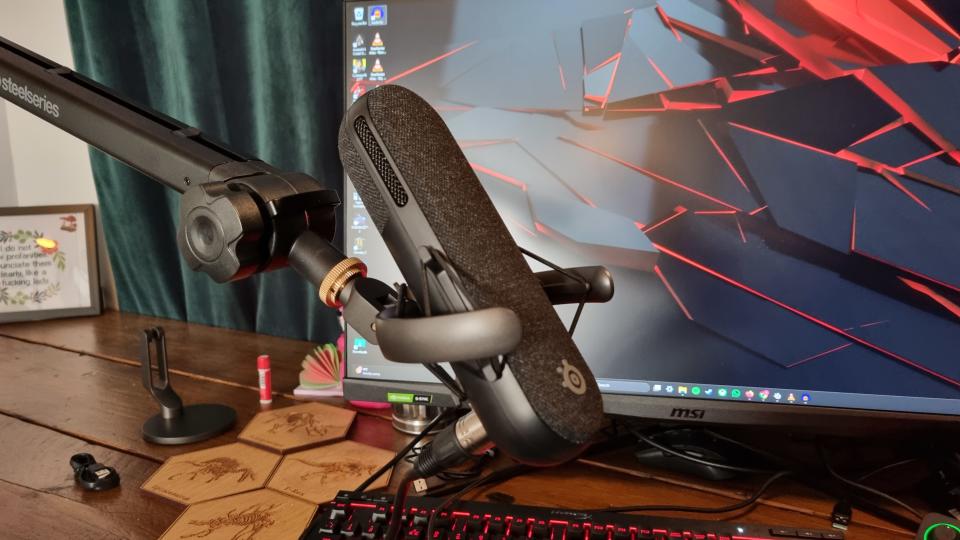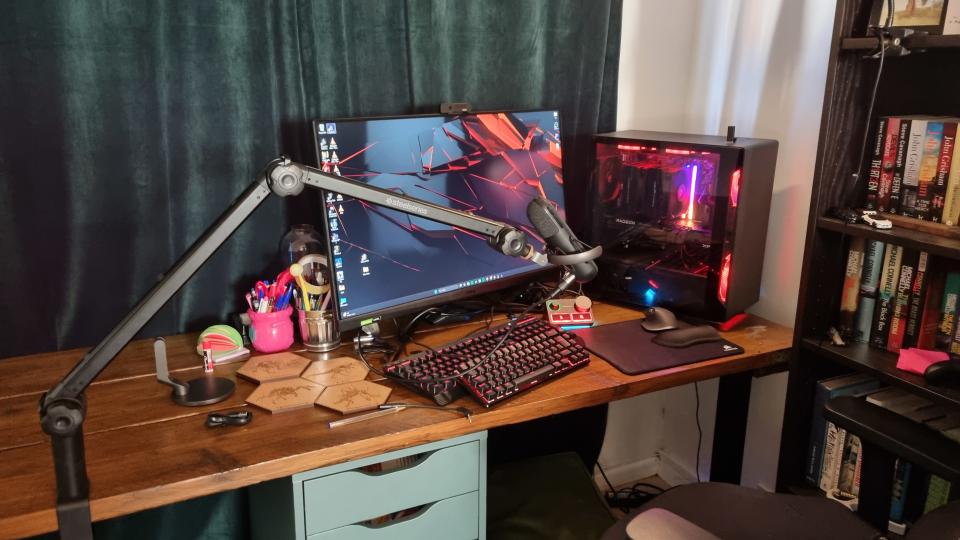For some, audio quality matters little beyond something that isn’t objectively terrible to listen to. If you just want something that sounds good enough to pass without comment in your next Discord chat or remote meeting, then there are plenty of microphones that will do the job just fine.
However, if you want to take things to a more professional sound level, perhaps for your next stream or podcast, things can get very complicated very quickly. Suddenly you find yourself in a world of polar patterns, XLR cables, preamp adjustments, compression sliders and all kinds of terminology that will make your head spin, and that’s before you plug in your first cable.
SteelSeries thinks it has the answer. Enter, the SteelSeries Alias Pro, the companion microphone for the regular SteelSeries Alias. With an MSRP of $330/£320, it’s playing with some big names, as our current favorite gaming microphone, the Shure MV7, comes in a similar price range. Then you better be good, right?
Unlike its little brother, the Pro version ditches the front-mounted controls and internal amplification for a separate mains-powered XLR control and amplifier unit called the Stream Mixer, which features two rear-mounted USB Type- C ports, complete with two Type-C to Type-A cables, a dedicated line-out and an XLR socket on the rear, also with supplied cable.
SteelSeries Alias Pro Specifications


Polar Patterns: Cardioid
Connectivity: XLR to USB dual PC connectivity via Stream Mixer
Record sample rate: 24 bit 96 kHz
Frequency response: 50–20,000 Hz
Functions: Includes XLR Stream Mixer and Preamp, +48V Phantom Power, Programmable Knobs and Knobs, SteelSeries Sonar Software
Price: $330/£320
All this connectivity is designed so that you can use the Stream Mixer to communicate with multiple inputs and outputs, including two PCs simultaneously for streaming and recording on separate systems, along with XLR connectivity that allows you to connect to a separate mixer or can use a completely different XLR-based microphone.
48V phantom power is included, meaning the preamp here should have no problem powering other XLR microphones from another manufacturer if you want to use the Stream Mixer with anything other than what’s included here.
In addition to all those extra connectivity options, the Stream Mixer is a compact and well-built little interface with two RGB-rimmed buttons and two rotary knobs. The left button acts as a dedicated microphone mute, while the right button can be assigned to different functions within the software.
As for those knobs, the smaller of the two is for adjusting gain, while the larger one can be programmed for all kinds of uses, including volume adjustment or adjusting a specific fader. Unlike the standard Alias with its built-in lights, the LED ring around the gain knob on the Pro acts as a meter, so red for clipping, yellow for close and green for within normal range, and the two knobs also change from color when pressed so you can easily see when you’re muted.


Like the regular Alias, the Alias Pro uses the excellent Sonar audio interface software, which again recognizes my connected input and output devices with minimal fuss. There were no issues distinguishing and identifying two PCs connected to the interface, meaning if you’re looking for a separate laptop for streaming, the Stream Mixer has you covered with a minimum of fuss.
There’s a lot of customization in the software here if you want it, including RGB lighting settings and watch face customization. When it comes to the audio features, the ClearCast AI noise cancellation is of particular interest, as it helped me tame the preamp’s increased gain while still maintaining a good signal level, along with a simple but powerful compressor reduced to a single slider. and an easy-to-use EQ with some well-thought-out presets.
In a desktop position using the included cradle it didn’t take long before I had a sound very similar to the regular Alias, as they both use a 1-inch/25mm capsule with a 50 Hz to 20 kHz cardioid pickup pattern that has no problem capturing good quality audio at a reasonable range.
However, SteelSeries also provided me with one of its Alias Boom Arms to play with, which currently costs just under $100/£80, and this is where the Alias Pro came into its own. In a close microphone position it didn’t take long before I got an excellent result.




It’s not that the Alias Pro is bad at remote recording compared to its little brother, in fact, far from it. However, when I connected it to the boom arm to get up close and experimented with the Sonar EQ, the qualities of that external preamp suddenly came into focus.
I recorded a few clips of both the Alias Pro on the desk mount and in a boom-mounted microphone configuration, and a reference clip of a microphone I know very well, the Shure MV7, also on a microphone boom at an identical distance.
I left the Shure unedited and raw as a baseline (keep in mind that if you buy one you only get the microphone and some relatively blunt software), while the Alias on the boom arm uses the Sonar EQ, noise reduction and compression .
Buy as…
✅ You’re looking for something more than a desktop microphone: For many gamers, a simple cardioid condenser microphone on your desk is all you really need. However, if you want to take things to the next level, that’s where the Alias Pro really shines.
✅ If you want to test the waters of studio sound but don’t know where to start: The Stream Mixer is a powerful preamp packed into a compact and easy-to-use package, and given the flexibility on offer, this will probably be all you need in an interface for now.
✅ If you just want to stream without the hassle: Setting up streaming audio, especially with multiple inputs and outputs, can be a head-scratching task. The Alias Pro with its Sonar software makes it much easier.
Don’t buy if…
❌ If you are on a budget: Yes, it’s expensive, and there’s no way around it.
❌ If you are not going to invest in a boom arm: While I’d choose something a little cheaper than the SteelSeries Boom Arm here, you’ll want something similar to really get the most out of that preamp and mic combination.
Thanks to that preamp, a tighter configuration, and the flexibility of the Sonar software, the Alias Pro is able to produce a very warm yet detailed sound that would be perfect for a podcast or audiobook recording, and great for a professional-sounding stream .
Of course the Shure MV7 is capable of producing a similar tone when equalized and processed, but keep in mind that you’ll have to do quite a bit of fiddling with some plug-ins to make that happen, while the Sonar software and the Stream Mix interface included here makes it easy.
For best results, though, you’ll need a boom arm like the Alias one I used here, and that gets expensive pretty quickly. For what it’s worth, while the SteelSeries Boom Arm is high quality and rugged, I’d be tempted to buy a cheaper arm and save some money since there are plenty of options on the market that do the same job for less, and the screw terminal on the back of the microphone itself is a standard size and should plug into most of them.
By comparison, a Shure MV7 combined with a decent audio interface/preamp, some plug-ins and a suitable arm will cost you the same money as the SteelSeries Pro and its arm, and many may lean towards the Shure brand when it comes to expenses. so much money for a studio-style audio setup, no matter how much fuss you’d have to do.
But where the SteelSeries Alias Pro really makes sense is as a leap into the realms of studio sound. The versatility of the preamp, the power of the flexible but easy to understand software and the qualities of that capsule come to the fore with very little fuss, meaning you can quickly and easily get the kind of audio normally reserved for professional setups .
That is quite an impressive achievement. Good audio is of course subjective, but I cannot deny that with the SteelSeries Pro you are tantalizingly close to a great result with just a few simple steps. Additionally, there’s the ability to set up the Stream Mixer with virtually any input and output you can think of, matched to the easy-to-use controls. It just makes the experience much, much smoother than a regular studio setup, and I have to tip my hat to that.
I think when it comes to pure sonic chops of the microphone itself, the Shure MV7 still just about has it, but honestly the Alias Pro’s preamp makes it surprisingly close.
Yes, it’s still pricey. But for studio-like sound with a lot less hassle, I think it’s worth it. Quality audio equipment often costs money, that’s true, but at least here you can leave the usual audio problems behind you and continue capturing great sound with ease.